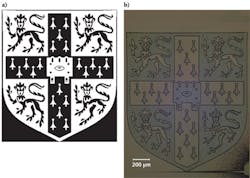PHOTOLITHOGRAPHY: Holography makes a bid in the search for maskless lithography
The hunt for the next big thing–or small thing–in lithography could do away with photomasks in favor of holograms, according to researchers at the University of Cambridge (England).
Industries that depend on photolithography always have an eye toward the future; the relentless shrinkage of device sizes and growth of component densities means that any cutting-edge technology for making lithographic features is soon to be supplanted. Industries keep the other eye toward their bottom line, and to date, one of the biggest contributors to capital costs in lithography is the photomask. Approaches that claim to allow so-called maskless lithography stand to save manufacturers tens of thousands of dollars each time a change is made in device design, no matter how large or small the change.
SLMs create phase holograms
Enter Cambridge's Centre of Molecular Materials for Photonics and Electronics. The center is host to a group that has long been working in the area of computer-generated holography. Crucial to the group's applications is the use of a liquid-crystal-on-silicon spatial light modulator (SLM). By displaying computer-generated phase holograms on the SLMs, the group has already demonstrated a dazzling array of applications, including 3D holographic video projection.1
Tim Wilkinson, who heads the group at Cambridge, joined with Nils Hubner of Pforzheim University (Germany) to demonstrate that the same approach could be used in lithography.
"It's basically the same technique, but rather than project a large image in 2D or 3D, we are trying to project an image with diffraction-limited features," Wilkinson says.
To demonstrate the approach, the researchers spin-coated standard photoresist onto microscope slides. They then used a 402-nm-emitting vertical-cavity surface-emitting laser as their light source, coupling it into single-mode fiber to improve beam quality.
To generate the holograms to be displayed, the team broke down its sample image–a University of Cambridge crest about 3 mm wide–into 20 subimages, with the optical system being used giving them a nominal pixel width of about 3.5 µm. They used a Gerchberg-Saxton phase-retrieval algorithm to generate holograms from a random starting phase, and for each subimage, they averaged five phase holograms from five different starting phases.
The Gaussian-profile, flat-phase beam was then passed through a polarizing beamsplitter and off of the SLM displaying the averaged holograms. The beam acquires the holographic phase shift, passes back through the beamsplitter, and is focused onto the slides to create photoresist patterns matching the image input into the SLM (see figure).
Fast prototyping
Crucially, the approach can be adapted to existing photolithography approaches, where the mask is replaced with a holographic optical projection system. That should make it most useful for rapid prototyping and refinement, with the approach's parallel nature inherently outperforming direct-write approaches using lasers or electron beams.
"Any diffractive optical element fabrication system, or industries such as printed circuit board manufacture and microwave circuits, could use this technique and save a fortune on masks," says Wilkinson.
The proof-of-principle experiments will give way to more refinements, he added. The group will go on to make multilevel patterns for 3D lithography, work to widen the projection area, and further optimize the photoresist response, whose nonlinearity may limit the approach's repeatability.
Creating holograms that are corrected for a given optical system's aberrations can push the resolution toward the diffraction limit. As the authors note, by knowing the precise shape of the laser spot, more elaborate holograms can be generated that permit a larger area to be exposed for each pattern.2
The team will also try to extend the resolution of the technique beyond the diffraction limit. Wilkinson adds that the technique "was not intended to push the limits of resolution but rather to make a cheap, rapid, repeatable system." As the approach gets more refined, those properties alone should make it a reasonable contender for future lithography.
REFERENCES
1. A. Cable et al., SID International Symposium Digest of Technical Papers, Vol. 35, 1431 (2004).
2. C. Bay et al., Opt. Lett., doi:10.1364/OL.35.0
D. Jason Palmer | Freelance writer
D. Jason Palmer is a freelance writer based in Florence, Italy.
